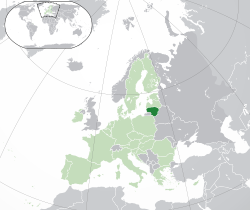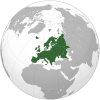लिथुआनिया
स्वरूप
Republic of Lithuania Lietuvos Respublika (Lithuanian) | |
|---|---|
 उल्लेखित नक्सा लिथुआनिया (dark green) – युरोप महादेश मा (green & dark grey) | |
 Location of Lithuania in the World | |
| राजधानी र सबैभन्दा ठूलो सहर | Vilnius 54°41′N 25°19′E / 54.683°N 25.317°E |
| सबैभन्दा ठूलो शहर | capital |
| आधिकारिक भाषाअन | Lithuanian |
Regional | Polish, Russian |
| जातिगत समूहअन (census 2019[१]) |
|
| रैथाने(एन) | Lithuanian |
| सरकार | Unitary semi-presidential republic[२][३][४][५] |
| Gitanas Nausėda | |
| Saulius Skvernelis | |
| Viktoras Pranckietis | |
| व्यवस्थापिका | Seimas |
| Independence | |
| 9 March 1009 | |
| 1236 | |
• Coronation of King Mindaugas | 6 July 1253 |
| 2 February 1386 | |
• Polish–Lithuanian Commonwealth created | 1 July 1569 |
| 24 October 1795 | |
| 16 February 1918 | |
| 15 June 1940 | |
| 22 June 1941 | |
| July 1944 | |
| 11 March 1990 | |
• Admitted to the United Nations | 17 September 1991 |
| 29 March 2004 | |
• Joined the European Union | 1 May 2004 |
| क्षेत्रफल | |
• जम्मा | 65,300 km2 (25,200 sq mi) (121st) |
• पानि (%) | 1.35 |
| जनसङ्ख्या | |
• 2020 लगत | |
• घनत्व | 43/km2 (111.4/sq mi) (173rd) |
| कुल ग्राहस्थ उत्पादन (क्रय शक्ति समता) | 2020 लगत |
• जम्मा | $107 billion[७] (83rd) |
• प्रति व्यक्ति | $38,751[७] (38th) |
| कुल ग्राहस्थ उत्पादन (साङ्केतिक) | 2020 लगत |
• जम्मा | $56 billion[७] (80th) |
• प्रति व्यक्ति | $20,355[७] (42nd) |
| गिनी (2018) | मध्यम |
| मानव विकास सूचकाङ्क (2018) | भौत उच्च · 34th |
| मुद्रा | Euro (€) (EUR) |
| समय क्षेत्र | अन्तर्राष्ट्रिय प्रमाणिक समय+2 (EET) |
• ग्रीष्मकालिन (दिवाप्रकाश समय बचत) | अन्तर्राष्ट्रिय प्रमाणिक समय+3 (EEST) |
| मिति ढाँचा | yyyy-mm-dd (CE) |
| सडक प्रयोग | right |
| टेलिफोन कोड | +370 |
| आइएसओ ३१६६ सङ्केत | LT |
| इन्टरनेट डोमेन | .lta |
वेबसाइट www | |
| |
लिथुआनिया युरोप महादेशमी रयाको एक देश हो।
यिन लै हेरऽ
[सम्पादन • स्रोत सम्पादन]
सन्दर्भअन
[सम्पादन • स्रोत सम्पादन]- ↑ "Ethnicity, mother tongue and religion". Official Statistics Portal. Statistics Lithuania. 12 December 2019. Archived from the original on 15 December 2018. Retrieved 15 December 2018.
- ↑ Kulikauskienė, Lina (2002). Lietuvos Respublikos Konstitucija [The Constitution of the Republic of Lithuania] (in Lithuanian). Native History, CD. ISBN 978-9986-9216-7-7.CS1 maint: unrecognized language (link)
- ↑ Veser, Ernst (23 September 1997). "Semi-Presidentialism-Duverger's Concept – A New Political System Model" (PDF) (in English and Chinese). Department of Education, School of Education, University of Cologne. pp. 39–60. Archived from the original (PDF) on 24 April 2021. Retrieved 23 August 2017.
Duhamel has developed the approach further: He stresses that the French construction does not correspond to either parliamentary or the presidential form of government, and then develops the distinction of 'système politique' and 'régime constitutionnel'. While the former comprises the exercise of power that results from the dominant institutional practice, the latter is the totality of the rules for the dominant institutional practice of the power. In this way, France appears as 'presidentialist system' endowed with a 'semi-presidential regime' (1983: 587). By this standard he recognizes Duverger's pléiade as semi-presidential regimes, as well as Poland, Romania, Bulgaria and Lithuania (1993: 87).
CS1 maint: unrecognized language (link) - ↑ Shugart, Matthew Søberg (September 2005). "Semi-Presidential Systems: Dual Executive and Mixed Authority Patterns" (PDF). Graduate School of International Relations and Pacific Studies. United States: University of California, San Diego. Archived from the original (PDF) on 19 August 2008. Retrieved 23 August 2017.CS1 maint: ref=harv (link)
- ↑ Shugart, Matthew Søberg (December 2005). "Semi-Presidential Systems: Dual Executive And Mixed Authority Patterns" (PDF). French Politics. Palgrave Macmillan Journals. 3 (3): 323–351. doi:10.1057/palgrave.fp.8200087. Archived from the original (PDF) on 4 March 2016. Retrieved 23 August 2017.
A pattern similar to the French case of compatible majorities alternating with periods of cohabitation emerged in Lithuania, where Talat-Kelpsa (2001) notes that the ability of the Lithuanian president to influence government formation and policy declined abruptly when he lost the sympathetic majority in parliament.
CS1 maint: ref=harv (link) - ↑ "Pradžia – Oficialiosios statistikos portalas". osp.stat.gov.lt.
- ↑ ७.० ७.१ ७.२ ७.३ "Lithuania". International Monetary Fund.
- ↑ "Gini coefficient of equivalised disposable income – EU-SILC survey". ec.europa.eu. Eurostat. Retrieved 12 September 2019.
- ↑ "2017 Human Development Report". United Nations Development Programme. 2015. Retrieved 24 March 2017.



